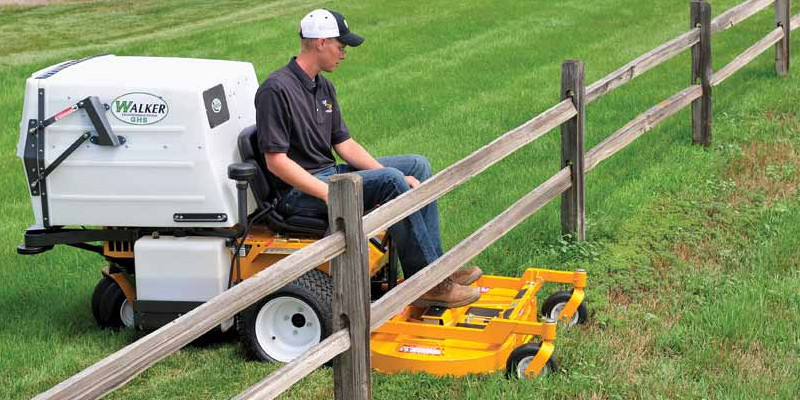As an out front mower manufacturer, Walker Manufacturing is more than a little biased about the value of owning and operating a mower equipped with a frontmount deck. Over the years, the industry has been less receptive, thanks in part to the cost advantages afforded by less-expensive mid-mount mowers.
When compared to their mid-mount counterparts, however, mowers with properly designed out front decks dramatically reduce trimming time, deliver a superior cut, give operators a clear view of what’s actually being mowed, and provide exceptional deck accessibility. The key words are “properly designed.”
Yes, other mowers with out front decks share many of the above attributes, but in addition, the Walker Mower will deliver the manicured, finished look that your customers have come to appreciate.

It All Begins With Deck Design
“Walker Mowers are perfect for us,” says Dana George, mowing manager for Tobin D. George Lawn Care in Greensburg, Pennsylvania (Walter Talk #39). “We maintain mostly residential properties. The mower allows us to get into tight corners and it doesn’t scalp.”
A big reason for Dana’s satisfaction is a true floating design that allows the deck to follow the contours of the lawn. It does this thanks to two design features: decreased weight on the front caster wheels using counterweight springs and a flexible carrier frame for the deck.
With Walker Mowers, only 7 to 16 percent of the overall weight is carried by the deck wheels, compared to the midmount competition’s 17 to 24 percent. Working in combination with a flexible carrier frame, the reduced weight allows the deck to easily float from both side to side and front to back.
As Dana relates, this makes a world of difference in the field. “With other mowers I’ve operated, if you approach a drainage ditch, the edge of the mower will dig into the lawn. This doesn’t happen with my Walker Mowers. We have 18 Walker Mowers and I’ve been using them since I started mowing lawns. Sometimes you just take their operation for granted—until you try another mower.”
Depending on the deck model Dana is using, one side will flex from 5 to 11 inches before the tire on the other side will lift off the ground. You can test a deck’s lateral flexibility right in your dealer’s showroom by simply lifting the deck wheel on one side and watching when the deck wheel on the other side raises.

Reach Not, Mow Not
Another reason for Dana’s satisfaction is the deck’s reach. Mid-mount machines simply cannot mow close to obstacles. Even most front-mounted machines leave too much trimming for another crew member with a string-line trimmer. The Walker Mower deck, on the other hand, has a lower profile on the front to give a reach advantage over other competitive front-mount and mid-mount models. This allows the operator to trim close—even under and around hard-to-reach areas such as low-hanging branches and fences.
Dana admits to taking a couple of other features for granted. Among them is the tilt-up deck that affords easy and safe access to the deck and blades. “We change the blades every evening,” he emphasizes. “A deck housing that is easy to clean gets cleaned more often, just as mower blades that are easy and safe to change get changed more often.”
Walker Mower decks are also easily interchangeable, and the mower can be fitted with different attachments to add to the machine’s year-round versatility.
Only if you’ve ever operated a Walker Mower or observed one in action can you appreciate how it literally floats over a lawn’s surface. It’s this agility that lends to the mower’s overall performance, and delivers a cut that is unrivaled within the industry.
The deck’s gentle footprint and floating design should not be confused with lack of durability. Deck engineering and design favors structural integrity over excess metal and weight—a design that will deliver optimum performance and a finished manicured look week after week, cut after cut.




 Site Search
Site Search



